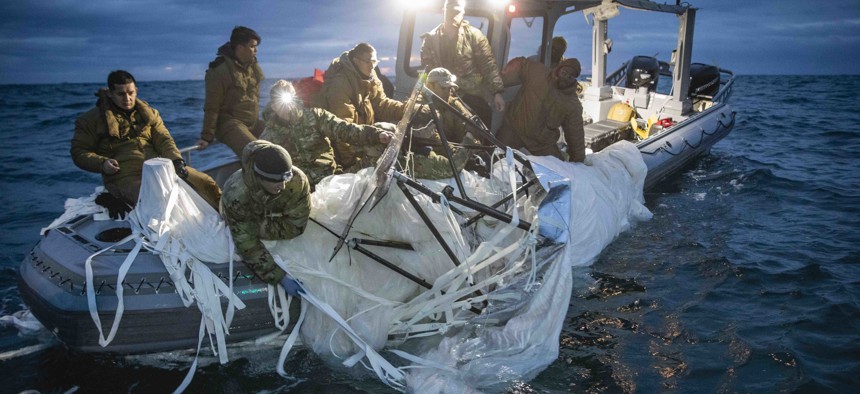White House Launches Effort to Examine Policy Choices for Shooting Down UFOs

Sailors assigned to Explosive Ordnance Disposal Group 2 recover a high-altitude surveillance balloon off the coast of Myrtle Beach, South Carolina, Feb. 5, 2023 U.S. Navy / Mass Communication Specialist 1st Class Tyler Thompson
NORTHCOM has changed radar settings to get “better fidelity on seeing slower objects,” general says.
The National Security Council will lead a team of experts to “study the broader policy implications for detection, analysis, and disposition of unidentified aerial objects,” White House National Security Council spokesperson John Kirby told reporters Monday.
“Every element of the government will redouble their efforts to understand and mitigate these events” he said. The news comes after U.S. military aircraft downed three unidentified objects over U.S. and Canadian airspace over the weekend, and just about a week after a U.S. F-22 took down a Chinese spy balloon off the South Carolina coast.
But while the circumstances of the three instances are similar, the Pentagon and White House have been addressing them individually. For example, the Pentagon was quick to publicly classify the Chinese balloon in terms of country of origin and intended use (surveillance of sensitive U.S. military sites.) But the government has yet to even describe the appearance of three smaller objects shot down over the weekend, much less offer a public theory as to where they came from or what they were doing over the United States and Canada. Kirby on Monday said only that they didn’t seem to have “self-propulsion,” and seemed to be moved primarily by the wind.
The U.S. military doesn’t “fully appreciate, understand exactly what we're seeing,” but a big part of the reason officials are seeing them is because of the decision to look for them, particularly following the first balloon incident, Air Force Chief of Staff Gen. C.Q. Brown said Monday. The balloon was “something that got all of our attention,” which prompted the military to more closely scrutinize U.S. airspace and adjust radar, “which means we're seeing more things than we would normally see,” he said.”
Gen. Glen VanHerck, the head of U.S. NORTHCOM and NORAD, told reporters Sunday, “What we're seeing is very, very small objects that produce a very, very low radar cross section.” He described the objects as “going at the speed of the wind, essentially,” which adds to the difficulty of identifying them. “Our pilots are 100 miles per hour [and trying] to give us what I would consider a factual, scientific-based description of what [they] see.”
The Defense Department has only recently been able to detect these sorts of phenomena at all, he said.
“Radars essentially filter out information based on speed so you can set various gates—we call them velocity gates—that allow us to filter out low-speed clutter. So if you had radars on all the time…we're looking at anything from zero speed up to say 100, you would see a lot more information,” he said. NORTHCOM has “adjusted some of those gates to “give us better fidelity on seeing slower objects. You can also filter out by altitude and so, with some adjustments, we've been able to get a better categorization of radar tracks now. And that's what I think you're seeing with these overall, plus there's a heightened alert to look for this information.” VanHerck did not say precisely when that decision was made.
The Pentagon is hesitant to categorize the objects without more information since a “range of entities including countries, companies, research organizations, operate objects at these altitudes for purposes that are not serious, including legitimate research,” Melissa Dalton, the assistant secretary of defense for homeland defense and hemispheric affairs told reporters Sunday,
One of the key goals of the new interagency effort led by the National Security Council will be to reach out to those entities, as well as allied governments to collect information on new types of unmanned aircraft that might explain the phenomena.
But those responses didn’t suffice for some members of Congress.
“These objects were identified after we basically opened the filters on radar and sensory equipment data. If true, we are potentially looking at one of the most staggering intelligence failures since 9/11. How long have these objects operated in our airspace with impunity? How long has the Pentagon been aware of them? Rep. Mike Gallagher, R-Wis., said in a statement. “Congress has urgent and vital oversight interests in all these questions, and most importantly, the American people deserve to know what’s going on in the skies above their homes. It’s time for answers.”
Brad Peniston contributed to this post.



